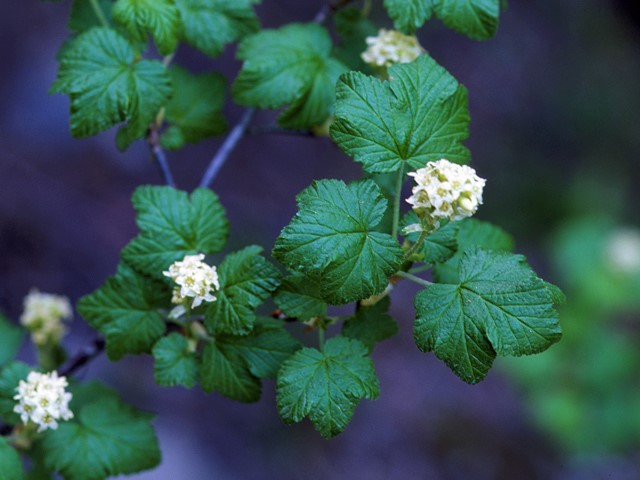Physocarpus Monogynus in the Landscape

Karen Panter, University of Wyoming
Scientfic Name: Physocarpus monogynusCommon Name: Mountain Ninebark
Description: Mountain ninebarks are compact shrubs with dense branching habits. The bark peels into papery strips leaving behind chocolate-colored inner bark underneath.
Native Habitat: Mountain ninebark is native to the western U.S., from as far south as Texas continuing north to Montana.
Cultural Requirement
Soil: Adapted to a wide range of soil types. Soil should be well-drained.
Moisture Tolerance: Moderate to regular water.
Sun/Shade/Preference: Full sun to part shade.
Transplanting: Easy
Propagation: Propagating from seeds is common and no treatments are necessary. Softwood cuttings taken in summer root well at 60F in a sand/peat medium. No rooting hormones are needed.
Maintenance (pruning, fertilization, deadheading, division, irrigation, etc): Remove dead stems in the spring. Pruning older stems to the ground will help rejuvenate mature plants. Moderate fertilization and irrigation are suggested.
Insect, disease, or other problems: Late season powdery mildew can occur; treatments are usually not necessary. Otherwise, none of major importance.
Landscape Value
Use in the Landscape: Mountain ninebarks work well massed together or as low hedges.
Weediness/Invasive Potential: None of concern.
Foliage: Alternate leaves, usually with 3 lobes. Not used for fall color.
Flower: Small and white or pink tinted, in clusters, attractive to pollinators.
Timing: May, June
Fruit: Reddish follicles in September, October. Seeds are eaten by many bird species.
Form: Some consider these shrubs shaggy in appearance.
Texture: Medium to coarse.
Ultimate Size: Mountain ninebarks will grow up to 3 feet tall and wide.
Rate of Growth: Medium to fast.
Suggested Plant Partners: Coarse texture, especially in winter, so may want to mix with softer textured evergreens.
Availability: Readily available from most larger nurseries, usually in containers, sometimes balled-and-burlapped.
Cultivars: P. monogynus is typically grown as the species; no cultivars are currently available.
References:
Dirr, M.A. 1998. Manual of woody landscape plants. Stipes Publishing Company, Champaign, Illinois.
Dorn, R.D. 1992. Vascular plants of Wyoming. 2nd edition. Mountain West Publishing, Cheyenne, Wyoming.
Hartmann, H.T., D.E. Kester, F.T. Davies Jr., and R.L. Geneve. 2011. Hartmann and Kester’s plant propagation. 8th edition. Prentice Hall, Upper Saddle River, New Jersey.
Sunset Western Garden Book. 2001. Sunset Publishing Corporation, Menlo Park, California.
USDA-NRCS Plants Database. https://plants.sc.egov.usda.gov/java/. Accessed 18 October 2019.Photo courtesy of https://www.wildflower.org/gallery/result.php?id_image=23760, by Sally and Andy Wasowski.

